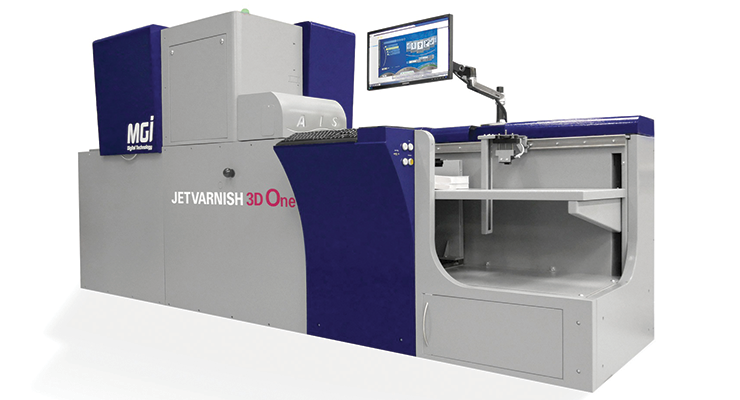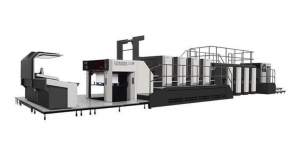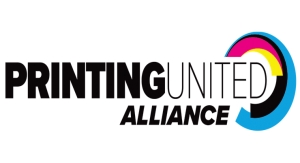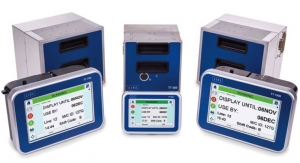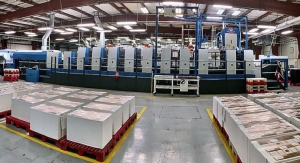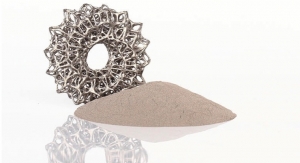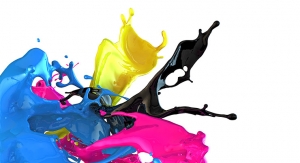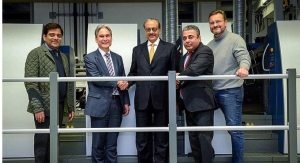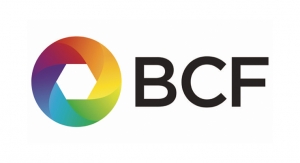Sean Milmo, European Editor09.21.20
Haptic printing is making print more competitive with electronic media by adding a sense of touch to printed surfaces.
Although haptics have been around for a long time, new technologies, particularly digital processes, can give it a powerful means of differentiating print at a time when the sight and sound of electronic displays dominate everyday life. It enables print to emphasize its physical characteristics against the virtual reality of online communications, where touch can be confined to the feel of a keypad.
Haptic printing turns the traditional flat, two-dimensional ink and paper into three-dimensional textures, patterns and sculptured effects, which are frequently combined with other sensory enhancements like metallic foils, chemical coatings and lamination films.
“The human eye perceives the layers of special effects and it resonates deeper into the consciousness,” said Jack Noonan, marketing manager of MGI Group, in which Konica Minolta is a major shareholder. “A finger that runs over the embellishments generates more neurological activity than mere optical awareness.”
However, COVID-19 is making it more difficult for the print sector to exploit its haptic advantages because of the way the pandemic has made people even more reliant on
online communications.
COVID-19 prompted more people, for example, to do their shopping online so that purchasing decisions would be made without the influence of the feel of haptic packaging. Research shows that textured packaging surfaces encourage consumers to think more about a product and whether to buy it.
Adding Quality to Packaging
Haptics incline consumers to perceive products as having greater quality and, hence, value. A growing number of consumer product companies are trying to use 3D and decorative features on packaging as a way of giving their brands an individual identity. This has been the case in cosmetics but is now extended to other sectors.
For ink, coatings and effects producers, the shift towards sensory marketing through touch is boosting demand for materials like varnishes, screen inks and foils and metallic effects.
Haptics is becoming part of the mainstream in finishing with customers wanting texturing and other three-dimensional effects not to be excluded from their options.
“Print service providers need to offer their customers a little bit of everything,” said Amit Shvartz, chief marketing officer at Scodix, a leading manufacturer of print enhancement equipment.
The company found from its own surveys that print buyers are prepared to pay between a quarter and close to 90% more for digital print enhancements than for CMYK-only work.
Advances in digital printing, especially its suitability for short-runs and personalization of printed products, has been a major influence behind the spread of haptic printing. Also, the versatility of digital printing has been an impetus since it can be used to provide texturing and patterning through variations in the compositions of layers of different inks
and coatings.
Layering, particularly of varnishes, is an example of a process in which printers can apply their own skills and expertise to create different three-dimensional effects.
Similar enhancements can be achieved through UV curing. Soft-touch surfaces of diapers packaging which mimic the feel of a baby’s skin can be achieved through UV coatings.
Almost any UV coating can be adjusted to provide surfaces with a specific feel, according to IST Metz, a UV materials specialist. It gives, as an example, wet-touch UV-curable coatings, which provide surfaces with a wet and fresh feel such as that on a glass of iced tea from a fridge.
“UV-curable coatings can be used on almost every material – film, paper, board – for any kind of product,” it pointed out.
But UV curing applications in haptics are now being supplemented by digital processes, which have the advantage of having greater flexibility and versatility. Inkjet is providing soft feel surfaces, although often with the aid of UV curing.
However, with inkjet, there is also the prospect of combining haptic enhancements with personalization effects.
Jackpot Peanut Butter, a London startup, has been using highly personalized labels as a major selling point behind its all-natural peanut butter brand.
The labels are printed on the company’s own desk-top inkjet printer and manually applied to the peanut butter jars. Despite their visual clout, the labels are almost exclusively 2D.
Now it wants to move away from what it sees as “bland” personalization to the “creative, giving consumers a three-dimensional experience,” according to the summary of a presentation by the company’s founder Rupert Leigh, due to be given at a London conference in November.
Among press equipment manufacturers, Scodix has been among the busiest in Europe. Thanks to the efforts of itself and other haptic printing players, enhancements are being brought inline by many printers in the region. This switch from being an offline activity or even one that is outsourced to other printers is a factor helping enhancement printing achieve double-digit annual growth rates.
Scodix offers, on a single machine, printing of real foil without the need for dies and molds, holographic foils, spot varnishes, crystals mounted on high-build polymer and glitter patterning and texturing.
However, with the fast growth of enhancement demand – although from a relatively low base – the European market has become much more competitive. Press equipment manufacturers have expanded into finishing with some big players entering the embellishment segment often to provide equipment for specific haptic functions.
Label equipment makers have introduced modular systems to provide a greater variety of applications that can be integrated into an inline process.
The GT series of machines of Cartes Srl incorporate equipment for silk screen printing, hot stamping, embossing and flatbed and semi-rotary laser die-cutting.
To demonstrate the versatility of its GT360 machine, it produced in August in one step with a semi-rotary die cutter an anniversary gold label using gold, bronze and silver hot stamping, embossing and white and black screen printing.
The company sees the increased popularity of enhancements being reflected in increases in printers’ investments in new technologies, particularly modular machines.
Because of its four screenprinting units, the Cartes GT 360 finishing presses are being used by some printers more for printing than finishing.
Cartes’ printer customers are reporting that vineyards and their label design agencies are wanting added value from screen finishing and embossing. Varnishing is seen in some sectors as being an essential enhancement.
Modular finishing machines give printers opportunities to gain competitive advantages through the addition of single modules. UK labels printer Baker Labels, Leeds, England, announced in June 2020 that the imminent installation of JetFx digital foil and high-build varnish module for the company’s AB Graphic finishing machine would make it the only trade label manufacturer in the country with digital embellishment capabilities.
“This is a very good fit in our strategy of finding new, cutting edge equipment that is pushing the boundaries of what can be produced in the labeling world,” managing director Steve Baker said.
Through its partnership with digital embellishment specialist MGI Group, Konica Minolta has been focusing on the varnish enhancement segment.
Konica sees varnish embellishments as a means for printers to move away from the “me-too” business model by differentiating themselves more distinctly without the need necessarily to offer a wide range of enhancements to customers.
“The visionary players in the market are currently investing in digital varnish technology, a new print embellishment technique that is unleashing new levels of creativity, differentiating products and enabling customers to offer a more attractive and memorable product,” said Konica Minolta.
As haptic printing generates increasingly elaborate and complex two and three-dimensional structures using mainly conventional printing processes, often with the help of digital technologies, the divide between itself and 3D additive manufacturing has started to narrow.
The convergence between the two was highlighted in March 2020 when Mimaki Europe, with a long tradition in conventional printing, launched a 3D printer aimed mainly at the signage and display markets but also manufacturing customers.
The idea is that the 3D printer would link up with Mimaki’s range of 2D printing equipment to decorate the 3D products.
The launch underlined the company’s dedication to being a “total solutions provider,” according to Bert Benckhuysen, Mimaki Europe’s senior product manager.
“Beyond the 3D printing stage, our Mimaki inkjet printers can then be utilized to add color and décor, making created objects even more impressive and immensely versatile,” he explained.
“We intend to lead the sign graphics industry in both two- and three-dimensional signages.”
European Editor Sean Milmo is an Essex, UK-based writer specializing in coverage of the chemical industry.
Although haptics have been around for a long time, new technologies, particularly digital processes, can give it a powerful means of differentiating print at a time when the sight and sound of electronic displays dominate everyday life. It enables print to emphasize its physical characteristics against the virtual reality of online communications, where touch can be confined to the feel of a keypad.
Haptic printing turns the traditional flat, two-dimensional ink and paper into three-dimensional textures, patterns and sculptured effects, which are frequently combined with other sensory enhancements like metallic foils, chemical coatings and lamination films.
“The human eye perceives the layers of special effects and it resonates deeper into the consciousness,” said Jack Noonan, marketing manager of MGI Group, in which Konica Minolta is a major shareholder. “A finger that runs over the embellishments generates more neurological activity than mere optical awareness.”
However, COVID-19 is making it more difficult for the print sector to exploit its haptic advantages because of the way the pandemic has made people even more reliant on
online communications.
COVID-19 prompted more people, for example, to do their shopping online so that purchasing decisions would be made without the influence of the feel of haptic packaging. Research shows that textured packaging surfaces encourage consumers to think more about a product and whether to buy it.
Adding Quality to Packaging
Haptics incline consumers to perceive products as having greater quality and, hence, value. A growing number of consumer product companies are trying to use 3D and decorative features on packaging as a way of giving their brands an individual identity. This has been the case in cosmetics but is now extended to other sectors.
For ink, coatings and effects producers, the shift towards sensory marketing through touch is boosting demand for materials like varnishes, screen inks and foils and metallic effects.
Haptics is becoming part of the mainstream in finishing with customers wanting texturing and other three-dimensional effects not to be excluded from their options.
“Print service providers need to offer their customers a little bit of everything,” said Amit Shvartz, chief marketing officer at Scodix, a leading manufacturer of print enhancement equipment.
The company found from its own surveys that print buyers are prepared to pay between a quarter and close to 90% more for digital print enhancements than for CMYK-only work.
Advances in digital printing, especially its suitability for short-runs and personalization of printed products, has been a major influence behind the spread of haptic printing. Also, the versatility of digital printing has been an impetus since it can be used to provide texturing and patterning through variations in the compositions of layers of different inks
and coatings.
Layering, particularly of varnishes, is an example of a process in which printers can apply their own skills and expertise to create different three-dimensional effects.
Similar enhancements can be achieved through UV curing. Soft-touch surfaces of diapers packaging which mimic the feel of a baby’s skin can be achieved through UV coatings.
Almost any UV coating can be adjusted to provide surfaces with a specific feel, according to IST Metz, a UV materials specialist. It gives, as an example, wet-touch UV-curable coatings, which provide surfaces with a wet and fresh feel such as that on a glass of iced tea from a fridge.
“UV-curable coatings can be used on almost every material – film, paper, board – for any kind of product,” it pointed out.
But UV curing applications in haptics are now being supplemented by digital processes, which have the advantage of having greater flexibility and versatility. Inkjet is providing soft feel surfaces, although often with the aid of UV curing.
However, with inkjet, there is also the prospect of combining haptic enhancements with personalization effects.
Jackpot Peanut Butter, a London startup, has been using highly personalized labels as a major selling point behind its all-natural peanut butter brand.
The labels are printed on the company’s own desk-top inkjet printer and manually applied to the peanut butter jars. Despite their visual clout, the labels are almost exclusively 2D.
Now it wants to move away from what it sees as “bland” personalization to the “creative, giving consumers a three-dimensional experience,” according to the summary of a presentation by the company’s founder Rupert Leigh, due to be given at a London conference in November.
Among press equipment manufacturers, Scodix has been among the busiest in Europe. Thanks to the efforts of itself and other haptic printing players, enhancements are being brought inline by many printers in the region. This switch from being an offline activity or even one that is outsourced to other printers is a factor helping enhancement printing achieve double-digit annual growth rates.
Scodix offers, on a single machine, printing of real foil without the need for dies and molds, holographic foils, spot varnishes, crystals mounted on high-build polymer and glitter patterning and texturing.
However, with the fast growth of enhancement demand – although from a relatively low base – the European market has become much more competitive. Press equipment manufacturers have expanded into finishing with some big players entering the embellishment segment often to provide equipment for specific haptic functions.
Label equipment makers have introduced modular systems to provide a greater variety of applications that can be integrated into an inline process.
The GT series of machines of Cartes Srl incorporate equipment for silk screen printing, hot stamping, embossing and flatbed and semi-rotary laser die-cutting.
To demonstrate the versatility of its GT360 machine, it produced in August in one step with a semi-rotary die cutter an anniversary gold label using gold, bronze and silver hot stamping, embossing and white and black screen printing.
The company sees the increased popularity of enhancements being reflected in increases in printers’ investments in new technologies, particularly modular machines.
Because of its four screenprinting units, the Cartes GT 360 finishing presses are being used by some printers more for printing than finishing.
Cartes’ printer customers are reporting that vineyards and their label design agencies are wanting added value from screen finishing and embossing. Varnishing is seen in some sectors as being an essential enhancement.
Modular finishing machines give printers opportunities to gain competitive advantages through the addition of single modules. UK labels printer Baker Labels, Leeds, England, announced in June 2020 that the imminent installation of JetFx digital foil and high-build varnish module for the company’s AB Graphic finishing machine would make it the only trade label manufacturer in the country with digital embellishment capabilities.
“This is a very good fit in our strategy of finding new, cutting edge equipment that is pushing the boundaries of what can be produced in the labeling world,” managing director Steve Baker said.
Through its partnership with digital embellishment specialist MGI Group, Konica Minolta has been focusing on the varnish enhancement segment.
Konica sees varnish embellishments as a means for printers to move away from the “me-too” business model by differentiating themselves more distinctly without the need necessarily to offer a wide range of enhancements to customers.
“The visionary players in the market are currently investing in digital varnish technology, a new print embellishment technique that is unleashing new levels of creativity, differentiating products and enabling customers to offer a more attractive and memorable product,” said Konica Minolta.
As haptic printing generates increasingly elaborate and complex two and three-dimensional structures using mainly conventional printing processes, often with the help of digital technologies, the divide between itself and 3D additive manufacturing has started to narrow.
The convergence between the two was highlighted in March 2020 when Mimaki Europe, with a long tradition in conventional printing, launched a 3D printer aimed mainly at the signage and display markets but also manufacturing customers.
The idea is that the 3D printer would link up with Mimaki’s range of 2D printing equipment to decorate the 3D products.
The launch underlined the company’s dedication to being a “total solutions provider,” according to Bert Benckhuysen, Mimaki Europe’s senior product manager.
“Beyond the 3D printing stage, our Mimaki inkjet printers can then be utilized to add color and décor, making created objects even more impressive and immensely versatile,” he explained.
“We intend to lead the sign graphics industry in both two- and three-dimensional signages.”
European Editor Sean Milmo is an Essex, UK-based writer specializing in coverage of the chemical industry.

